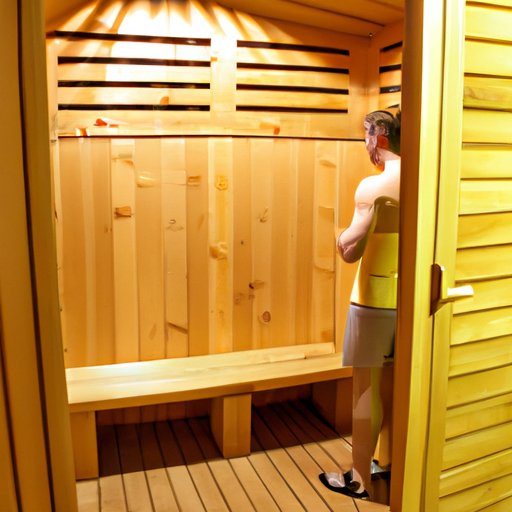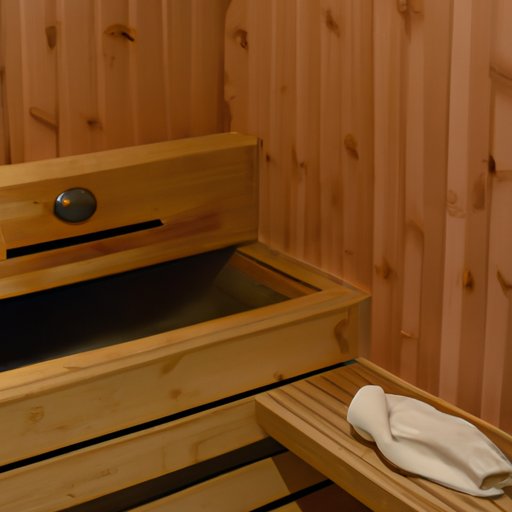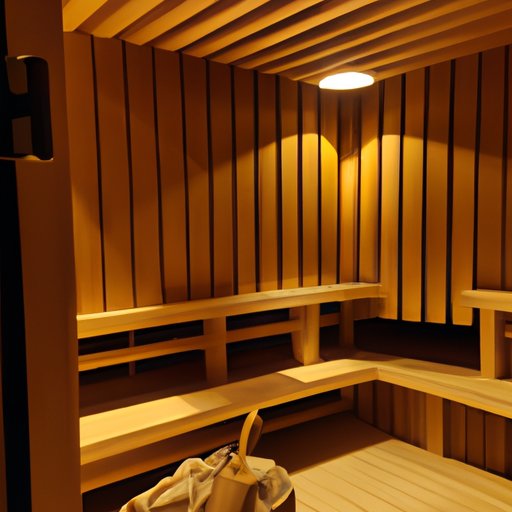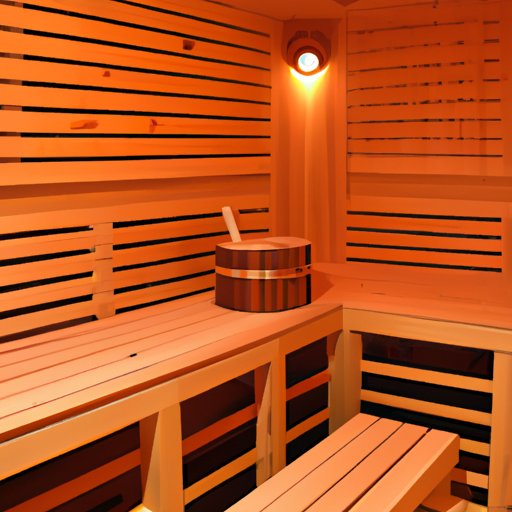Introduction
Saunas have been used for centuries as a way to relax and promote physical and mental wellbeing. But are saunas healthy? In this article, we’ll explore the potential health benefits and risks associated with sauna use, as well as comparing traditional and infrared saunas. We’ll also examine how saunas may improve athletic performance and mental health.

Examining the Health Benefits of Saunas
There are many potential health benefits associated with sauna use, including improved circulation, cleansing of toxins, relief from aches and pains, and improved respiratory health. Let’s take a closer look at each of these.
Improved Circulation
One of the main benefits of sauna use is improved circulation. The heat generated by the sauna causes your blood vessels to dilate, which increases blood flow throughout your body. This can help reduce stiffness in your joints and muscles, and can also help improve your cardiovascular health by lowering your blood pressure.
Cleansing of Toxins
The intense heat of a sauna helps your body sweat out toxins, such as heavy metals, chemicals, and other impurities. Sweating is one of the body’s natural ways of eliminating toxins, and it can be especially effective when combined with the heat of a sauna.
Relief from Aches and Pains
The heat of a sauna can also provide relief from muscle aches and pains. The heat helps increase blood flow to the affected area, which can help reduce inflammation and promote healing. The warmth of the sauna can also help relax tense muscles and provide relief from chronic pain.
Improved Respiratory Health
The heat and humidity of a sauna can help improve your respiratory health by loosening mucus and clearing your airways. This can help reduce the symptoms of respiratory conditions such as asthma and bronchitis, as well as helping to prevent colds and flu.

Exploring the Risks of Sauna Use
While there are many potential health benefits associated with sauna use, there are also some risks that you should be aware of. These include dehydration, heat exhaustion, and burns.
Dehydration
Sweating heavily in a sauna can lead to dehydration if you don’t drink enough water before, during, and after your session. Dehydration can cause dizziness, fatigue, and headaches, so it’s important to make sure you stay hydrated while using a sauna.
Heat Exhaustion
Spending too long in a sauna can lead to heat exhaustion, which is a potentially serious condition. Symptoms of heat exhaustion include nausea, headache, dizziness, and weakness. If you experience any of these symptoms, it’s important to leave the sauna immediately and seek medical attention if necessary.
Burns
It’s possible to get burned while using a sauna, especially if you’re not careful. Burns can occur if the temperature of the sauna is too high, or if you spend too long in the sauna. To avoid burns, it’s important to follow the manufacturer’s instructions and make sure that the temperature of the sauna is set to a comfortable level.
Comparing Different Types of Saunas
There are two main types of saunas – traditional saunas and infrared saunas. Each type has its own unique benefits and drawbacks, so let’s take a look at how they compare.
Traditional Saunas
Traditional saunas use hot air to generate heat, which is then circulated around the sauna by a fan. They tend to be more expensive than infrared saunas, but they can reach higher temperatures and provide a more intense sauna experience. However, they can also be difficult to install and maintain.
Infrared Saunas
Infrared saunas use infrared light to generate heat, which is then absorbed by your body. They tend to be cheaper than traditional saunas, and they’re easier to install and maintain. However, they don’t reach as high temperatures as traditional saunas, and the heat can feel less intense.
Investigating How Saunas Help with Athletic Performance
Saunas can also be beneficial for athletes. The increased circulation caused by the heat can help improve endurance and reduce recovery times, making it an ideal tool for athletes looking to maximize their performance.
Increased Endurance
The increased circulation caused by the heat of a sauna helps deliver oxygen and nutrients to your muscles more efficiently, which can help improve your endurance. This can be beneficial for athletes who need to sustain their performance over long periods of time.
Improved Recovery Times
The heat of a sauna can also help reduce lactic acid build-up in your muscles, which can help speed up recovery times. This can be especially beneficial for athletes who need to recover quickly between workouts.

Exploring How Saunas Affect Mental Health
In addition to the physical benefits, saunas can also have a positive effect on your mental health. The heat of a sauna can help reduce stress levels, and it can also improve your mood.
Stress Reduction
The heat of a sauna can help reduce stress levels by inducing a state of relaxation. This can be beneficial for anyone who is feeling stressed or overwhelmed, as it can help clear your mind and give you a chance to relax.
Improved Mood
The heat of a sauna can also help improve your mood. The increased circulation helps boost endorphin levels, which can help lift your mood and make you feel happier and more relaxed.
Understanding the Differences between Traditional and Infrared Saunas
When deciding which type of sauna to use, it’s important to understand the differences between traditional and infrared saunas. Here are some key points to consider:
Temperature Differences
Traditional saunas can reach higher temperatures than infrared saunas, so they can provide a more intense sauna experience. However, infrared saunas can still reach temperatures of up to 150°F, which is hot enough to produce the same health benefits.
Health Benefits
Both traditional and infrared saunas offer similar health benefits, such as improved circulation and relief from aches and pains. However, infrared saunas may be more beneficial for those with respiratory conditions, as the lower temperatures can be easier to tolerate.
Cost Considerations
Traditional saunas tend to be more expensive than infrared saunas, as they require more energy to run. However, the initial cost of an infrared sauna can be offset over time through lower energy bills.
Conclusion
Saunas can offer many potential health benefits, including improved circulation, cleansing of toxins, relief from aches and pains, and improved respiratory health. However, there are also some risks associated with sauna use, such as dehydration, heat exhaustion, and burns. When deciding which type of sauna to use, it’s important to consider the differences between traditional and infrared saunas. Both types can offer similar health benefits, but infrared saunas may be more suitable for those with respiratory conditions. Saunas can also be beneficial for athletes, as the increased circulation can help improve endurance and reduce recovery times. Finally, saunas can also have a positive effect on mental health, as the heat can help reduce stress levels and improve mood. Overall, saunas can be a great way to relax and promote physical and mental wellbeing.
(Note: Is this article not meeting your expectations? Do you have knowledge or insights to share? Unlock new opportunities and expand your reach by joining our authors team. Click Registration to join us and share your expertise with our readers.)
